chapter 12- membrane transport
1/77
There's no tags or description
Looks like no tags are added yet.
Name | Mastery | Learn | Test | Matching | Spaced |
|---|
No study sessions yet.
78 Terms
simple diffusion- far to slow for molecules to cross the lipid bilayer how is their passage across the cell acceletated
Facilitated transport
their passage across the cell is accelerated by specialized membrane transport proteins
Rate @ which a molecule diffuses across the lipid bilayer depends on?
size
solubility
smaller the molecule + the more hydrophobic (nonpolar)…
the more rapidly it will diffuse across the lipid bilayer
Rate of diffusion
Small non polar molecules
small uncharged polar molecules
Larger Uncharged polar molecules
ions
Small non polar molecules
O2
CO2
N2
steroid hormones
all dissolve rapidly in lipid bilayers - diffuse rapidly
Uncharged polar molecules
Water
ethanol
glycerol (crosses less rapidly 92 daltons)
uneven distribution of electric charge
will diffuse across the bilayer, but only if they are small enough
Larger uncharged polar molecules
glucose
nucleosides
some amino acids
barely cross at all
Ions
lipid bilayers are highly impermeable to all charges substances including ions no matter how small.
charges on the ions, strong electrical attraction to water molecules inhibit their entry
examples of ions
H+
Na+
K+
Mg+
Ca+
Cl-
HCO3-
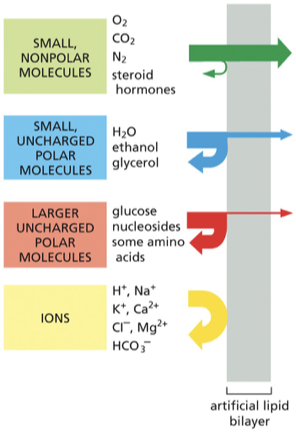
How do cells regulate the cells molecular traffic
The biological membranes are selectively permeable
so they don’t let everything go through
Inorganic ions and small polar organic molecules can cross a cell membrane through?
either a transporter or a channel
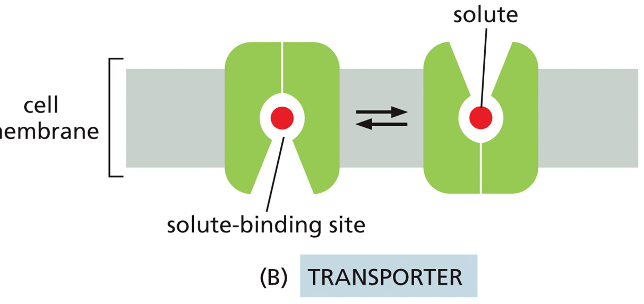
Transporter
transfers molecules or ions that fit in the binding sites on the protein
undergoes a series of conformational changes to transfer small solutes across the bilayer
VERY SELECTIVE (high specificity)
transfer solutes at a much lower rate than channels
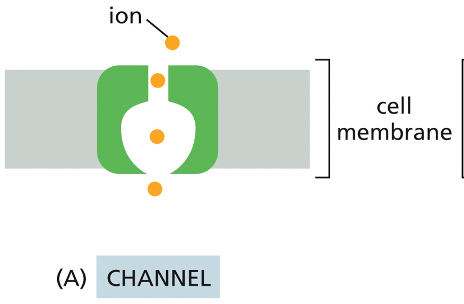
Channels
forms a pore across the bilayer, through which specific inorganic ions or, in some cases, polar organic molecules can diffuse.
when the channel is open only ions of an appropriate size and charge can pass through
ion concentration
ion concentration inside of the cell different than the outside of the cell
name some of the most important inorganic ions for cells
Na+, K+, Ca2+, Cl–, and H+ (protons)
the movement of these across the cell membrane plays an essential role in many biological processes + production of ATP
________ is the most plentiful positively charged ion (cation) outside of the mammalian cell, where as ___ is the most abundant inside.
options:
H+
Na+
K+
Mg+
Ca+
Cl-
HCO3-
Na+
K+
The high concentration of Na+ outside of the cell is electrically balanced by extracellular ____
options:
H+
Na+
K+
Mg+
Ca+
Cl-
Cl-
High concentration of K+ inside is balanced by?
a variety of negatively charged inorganic and organic ions (anions), including nucleic acids, proteins, and many cell metabolites
Movement across the membrane is also dependent upon the concentration of molecules
true or false
true
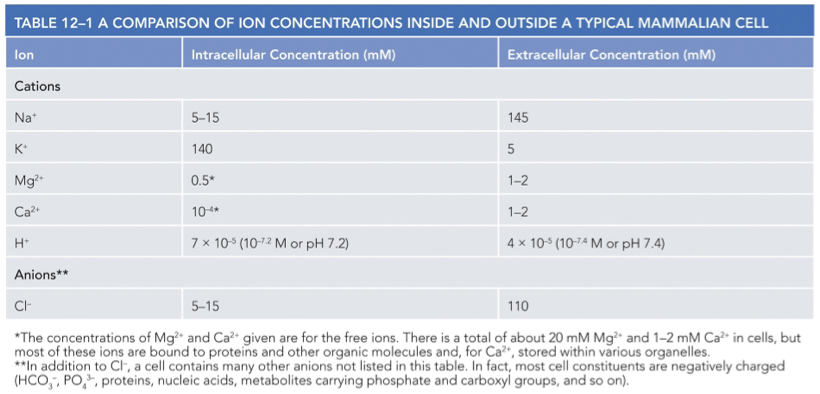
Membrane potential
voltage difference across a membrane due to slight excess of positive ions on one side and of negative ions on the other
exerts a force on any substance that carries a neg charge
tends to pull + charged ions/ molecules into the cell
drives neg char ions out
Substances will spontaneously flow?
downhill
region of high concentration to a region of low concentration
this is passive because there is no additional driving forces
Passive transport vs Active transport in the plasma membrane
Passive Transport ( [high] to [low]) (downhill)
The spontaneous movement of a solute down its concentration gradient across a cell membrane via a membrane transport protein, such as a channel or transporter
w/ out needing NRG
Active transport ( [low] to [high]) (uphill)
movement of solute against its electrochemical gradients; requires an input of NRG, such as the nrg provided by ATP hydrolysis.
couples the transport to some other process that provides an input of energy
Carried out by pumps (harness an NRG source such as hydrolysis of ATP to power the transport process)
![<p><strong>Passive Transport ( [high] to [low]) (downhill) </strong></p><p>The spontaneous movement of a solute down its concentration gradient across a cell membrane via a membrane transport protein, <u>such as a channel or transporter </u></p><ul><li><p>w/ out needing NRG </p></li></ul><p><strong>Active transport ( [low] to [high]) (uphill)</strong></p><p>movement of solute against its electrochemical gradients; requires an input of NRG, such as the nrg provided by ATP hydrolysis. </p><ul><li><p>couples the transport to some other process that provides an input of energy</p></li><li><p><u>Carried out by pumps </u>(harness an NRG source such as hydrolysis of ATP to power the transport process) </p></li></ul><p></p>](https://knowt-user-attachments.s3.amazonaws.com/3a82bbdf-3d3f-4f45-941d-770abdca32d0.png)
___________ is required to move anything against its concentration gradient
Energy input
True or false
Molecules and ions don’t freely diffuse down their concentration gradient
false
Molecules and ions will freely diffuse down their concentration gradient—no input of energy required
Electrochemical gradient
what is it
discuss sodium and potassium
The driving force that determines which way an ion will move across a membrane
combined influence of the ions concentration and the membrane potential
There is also an electrochemical gradient established by the (-) charged phospholipids and ion concentrations inside and outside the cell
Sodium
goes + outside of the cell to - inside of the cell
Na+ therefore tends to pour into cells when given an opportunity
If the voltage + concentration gradients have opposing effects the electrochemical gradient = small
ex: Potassium
K+, which is present at a much higher concentration inside cells, where the resting membrane potential is negative.
The membrane potential acts against the concentration gradient, decreasing the electrochemical driving force. Such is the case for K+.
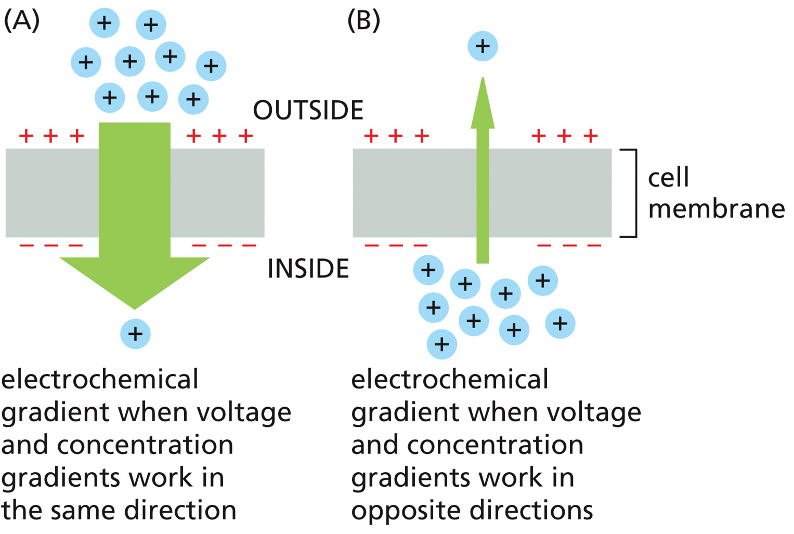
Water moves across cell membranes ____ its concentration gradient. A process called ________
down
osmosis
Aquaporins
channel that helps with transporting water NOT ions, across cell membranes
the aquaporins found in the plasma membrane increase a cells permeability to water
For cells that are responsible for moving large volumes of fluid like the ones in the kidney/ various secretary glands the aquaporins are essential for their function
the total concentration of solute particles inside the cell is called
osmolarity
generally exceeds the solute concentration outside the cell
osmotic gradient tends to pull water
into the cell
out of the cell
Choose one
into the cell
Osmosis
passive movement of water across a cell membrane from a region where the concentration of water is high ( bc the conc of solutes is low) to a region where the concentration of water is low ( and the concentration of solutes is high)
how do animals maintain osmotic equilibrium
animal cells
use transmembrane pumps to expel the solutes such as Na+ ions that draw water into the cell
Which type of membrane transport protein can perform both active and passive transport?
A. channels
B. Channels and transporters
C. Neither
D. Transporters
Transporters
Only transporters can move a solute against its concentration gradient. Some transporters also allow passive transport of molecules down their concentration gradient.
channels are always passive
but transporters can be active when they are pumps
When glucose moves across a phospholipid bilayer by passive transport, which factor determines the direction of its transport?
A. charge difference across the membrane
B. amount of energy available to fuel the transport process
C. whether the cell is metabolically active or not
D. the concentrations of glucose on either side of the membrane
D.
the concentrations of glucose on either side of the membrane
Glucose, a large, uncharged molecule, moves across the membrane through the action of a glucose transporter, not a pump. Therefore, the direction it moves is determined by its concentration gradient alone.
True or false
Na+ is the most plentiful positively charged ion outside the cell, while K+ is the most plentiful inside.
true
Each cell has its own characteristic set of transporters, explain
the plasma membrane contains transporters that import nutrients such as sugars, amino acids, and nucleotides
the lysosome membrane contains a H+ transporter that imports H+ to acidify the lysosome interio and the other transporters that move digestion products
inner mitochondria contains transporters for importing the pyruvate that mitochondria use as fuel for generating ATP
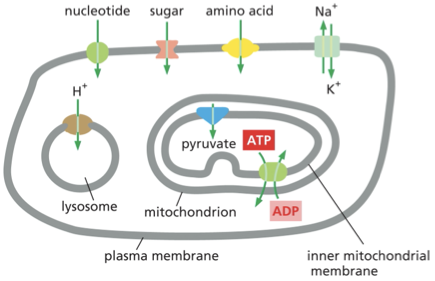
Glucose (uncharged) across the plasma membrane
passive transport
facilitated by a glucose transporter
can adopt several conformations and it switches reversibly and randomly between them
one confirmation: transporter exposes binding sites for glucose to the exterior of the cell and in another the sites to the cell interior
selective only binds to D-glucose
electrochemical gradient = 0 bc glucose is uncharged
direction it is transported is determined by its concentration gradient alone
What happens when you just ate and the glucose is plentiful outside cells
the sugar will bind to the transporters externally displayed binding sites
if the protein switches conformation - it will carry the bound sugar inward and release it into the cytosol where the the glucose concentration is low
when glucose levels are low and your hungry what happens
glucagon (hormone) stimulates the liver to produce large amounts of glucose by the breakdown of glycogen
result: the glucose concentration is higher inside liver cells than outside them

describe this figure
Transport or carrier proteins bind to their cargo in this case glucose which results in a shape change, then they release the cargo on the other side of the membrane
this is driven by concentration of the molecule
the figure shows 3 conformational states
outward open state (Ready to receive, site exposed)
occluded state (center) site not accessible
inward state: site exposed on the inside of the bilayer
The transition between the states is random and reversible, does not depend on whether the solute-binding site is occupied
if the solute concentration is higher on the outside of the bilayer, solute will bind more often to the transporter in the outward-open conformation than in the inward-open conformation, and there will be a net transport of glucose down its concentration gradient.
Active transport requires energy input from?
Gradient of another molecule
ATP
Light
why do you need this energy? because we are moving against the gradient
The Na/K pump use about _____ % of all of your ATP
25%
Cells depend on transmembrane pumps which carry out active transport in 3 main ways
name and explain the 3 ways
Gradient driven pumps: link the uphill transport of one solute across a membrane to the downhill transport of another
ATP driven pumps use the energy released by the hydrolysis of ATP to drive uphill transport
Light driven pumps - mainly found in bacterial cells use energy derived from sunlight to drive uphill transport
These different forms of active transport are often linked
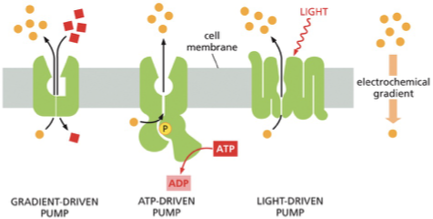
The Na+ pump
ATP driven
the pump uses the energy derived from ATP hydrolysis to transport Na+ out of the cell as it carries K+ in
sometimes called the Na+–K+ ATPase or the Na+–K+ pump.
During the pumping process, the energy from ATP hydrolysis fuels a stepwise series of protein conformational changes that drives the exchange of Na+ and K+ ions. As part of the process, the phosphate group removed from ATP gets transferred to the pump itself
•Establishes the high concentration of Na outside of the cell and K inside of the cell
•These concentration gradients are used as the energy carry out many other cellular activities
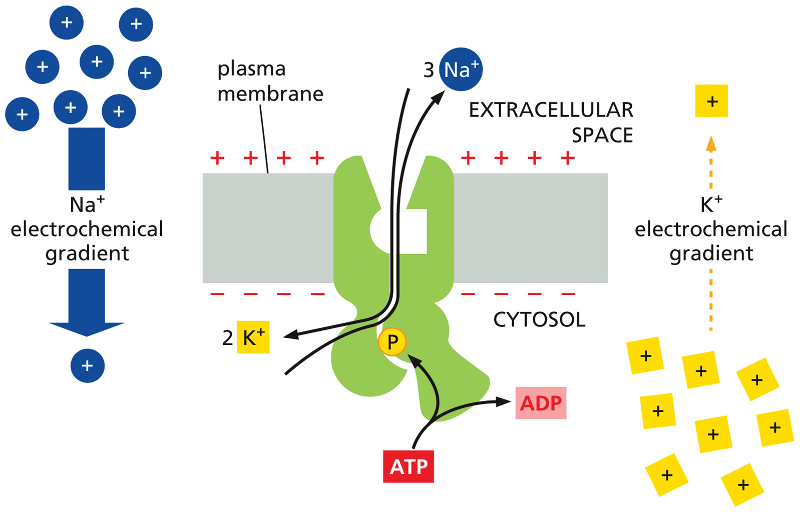
•Na/K pump functions through a series of conformational changes involving phosphorylation via ATP use
Results in?
•Results in 3Na+ exiting the cell and 2K+ entering the cell for each ATP hydrolyzed
•Creates a large electrochemical potential/ gradient of the membrane
The binding of cytosolic Na+ (1) and the subsequent phosphorylation by ATP of the cytosolic face of the pump (2) induce the protein to undergo conformational changes that transfer the Na+ across the membrane and release it outside the cell (3). The high-energy linkage of the phosphate to the protein provides the energy to drive the conformational changes. The binding of K+ from the extracellular space (4) and the subsequent dephosphorylation (5) allow the protein to return to its original conformation, which transfers the K+ across the membrane and releases it into the cytosol (6).
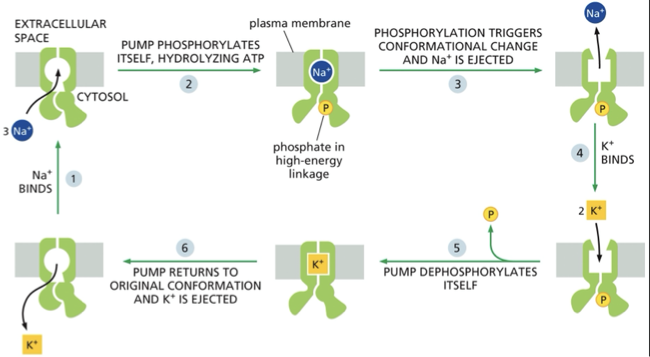
What happens if one step of the sodium-potassium pump cycle is blocked?
the entire cycle is blocked
ex: the toxin ouabain inhibits the Na+ pump by preventing the binding of extracellular K+
Calcium pumps (Ca2+)
Definition: active transporter that uses energy supplied by ATP hydrolysis to actively expel (Ca2+) from the cytosol.
is an ATP driven pump, moves Ca into the ER (sarcoplasmic reticulum in muscle cells)
kept at low concentration in the cytosol
(Ca2+) is less plentiful then Na+
(Ca2+) can bind tightly to a variety of proteins in the cell, altering activities
an influx of calcium into the cytosol through the channels used by different cells as an intracellular signal to trigger processes like muscle contractions, fertilization, or nerve cell communication
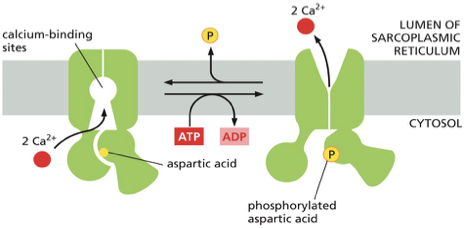
Gradient Driven Pumps
What is it
symport vs antiport vs uniport
Definition: a protein that uses energy stored in the electrochemical gradient of ions to actively transport a solute across the membrane
the downhill movement of the 1st solute down its gradient provides the energy to power uphill transport of the 2nd solute.
Symport: pump moves a pair of solutes in the same direction across the membrane
aniport: moves them in opposite directions
uniport : only one molecule is transported, down the concentration gradient through passive diffusion and doesnt pump
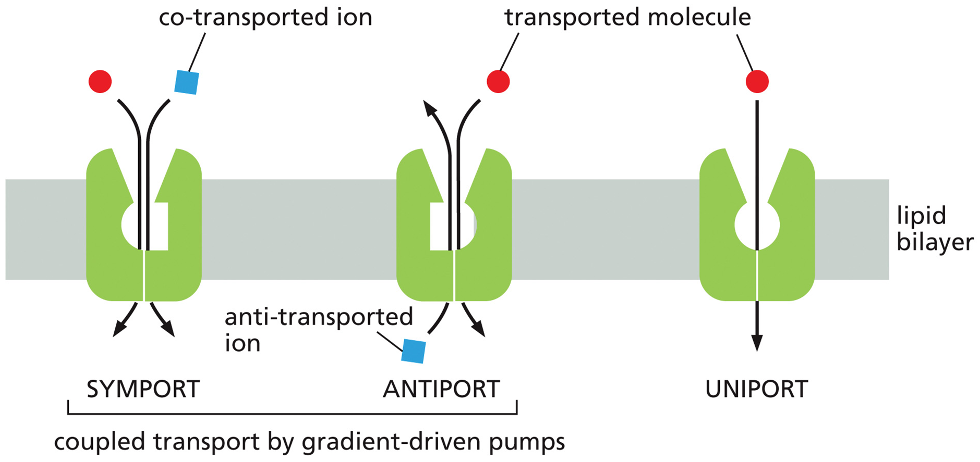
The concentration gradients established by ATP and light driven pumps are now energy sources to drive ________
gradient driven pumps
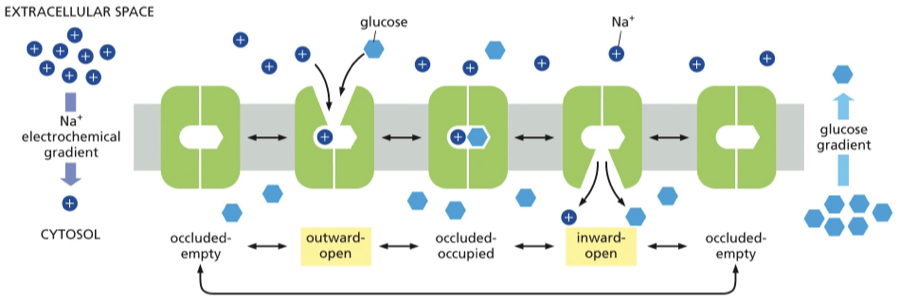
Symporter in regards to the glucose- Na+ symport
glucose- Na+ symporter imports glucose into the intestinal epithelial cells- against the gradient of glucose, and with the gradient of sodium
the glucose- Na+ symporter is bringun it in against gradient and then the basal layer transporter allowing it to exit with its gradient
The polarization of intestinal epithelial cells and the confinement membrane proteins to particular locations allows for directional movement of glucose _______
out of the intestine and into the blood stream
driven by the Na/K pump establishing Na gradient
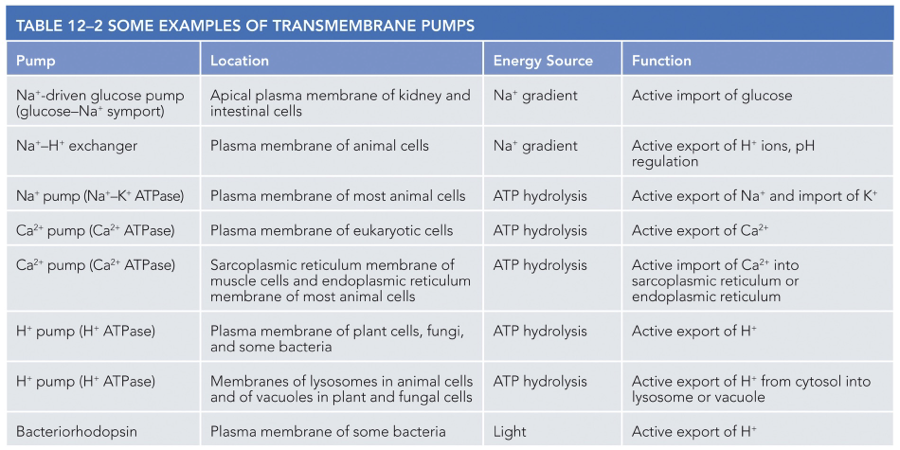
remember LIGHT can be an energy source for pumps look at bacteriorhodopsin
Plant cells, bacteria, and fungi (including yeast) do NOT have sodium pumps in their plasma membrane, instead they rely mainly on?
the H+ pumps in the plasma membrane that pump H+ out of the cell, this sets up an electrochemical proton gradient across this membrane that creates an acid pH surrounding the cell
The epithelial cells that line the gut have glucose–Na+ symport proteins that actively take up glucose from the lumen of the gut after a meal, creating a high glucose concentration in the cytosol. How do these cells release that glucose for use by other tissues in the body?
the cells have glucose uniports in their plasma membrane
When the glucose–Na+ symport protein is in its outward-open state, which is more likely to occur?
Na+ binds to its binding site.
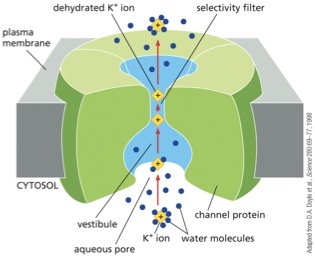
What distinguishes ion channels?
ion selectivity
selectivity filter:
part of the ion channel that determines which ions the channel can transport ; located in the region where the channel is narrowest
not continously open
most are gated
not open at all times, constantly flucuating between open and closed, this is regulated by particular ligands
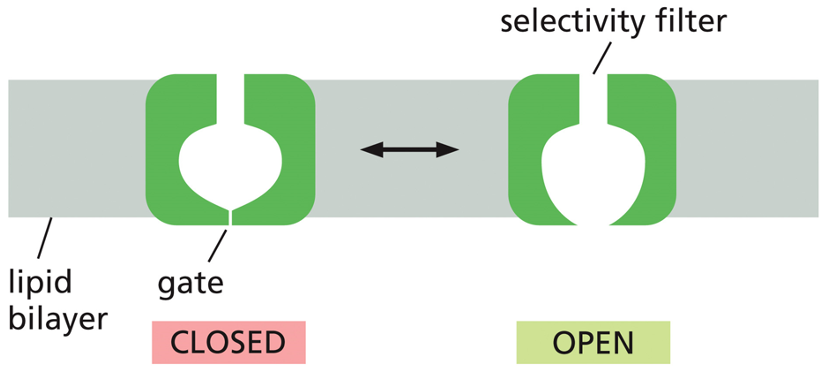
•In the K+ channel, _____is too big to enter w/H2O attached, too small to interact w/ the selectivity filter without H2O attached.
Na+
Does an ion channel need to undergo a conformational change ?
no unlike a transporter the ion channel does not need to undergo conformational changes for each ion to pass through
advantage w/ respect to the max rate of transport
Can a channel couple the ion flow to an energy source to carry out active transport?
no.
they simply make the membrane permeable to selected inorganic ions mainly Na+, K+, Ca2+, or Cl–.
K+ leak channels
allow K+ to move freely across the membrane
K+ leak channels contribute significantly to the resting membrane potential
in resting cells K+ are the main ion channels open in the plasma membrane
K+ exit from cells down its gradient, is limited by the (+) charge on the outside of the membrane
changes to the electrical gradient across the membrane can cause significant changes in the movement of ions across the membrane
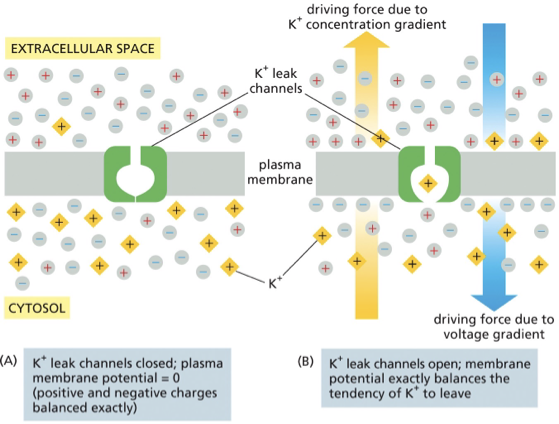
Name and explain the 3 ways that ion channels are regulated
Mechanically gated channel: the channel is pulled open in response to physical force
Ligand- gated channel: controlled by the binding of a molecule
Voltage- gated channel: opening is controlled by the membrane potential
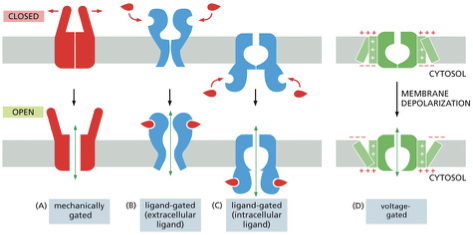
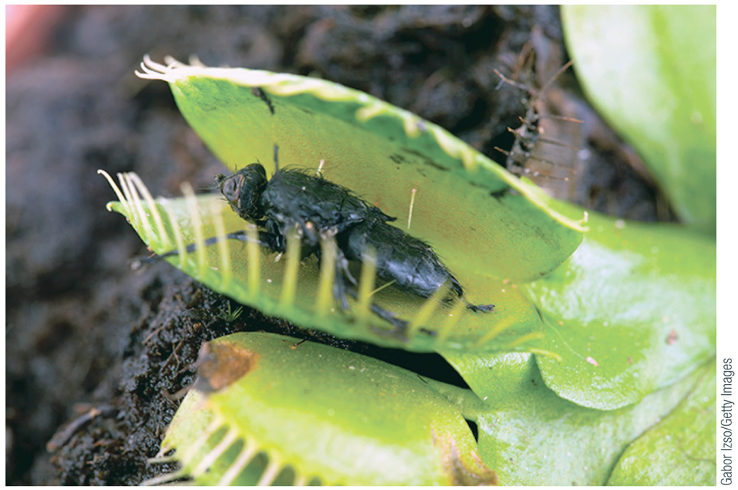
explain how the venus fly trap works in regards to ion channels
physical triggering of ion channels result in a change of membrane voltage - -triggering voltage gated channels— leading to larger H2O changes in cells at the base of the leaf closing the leaves
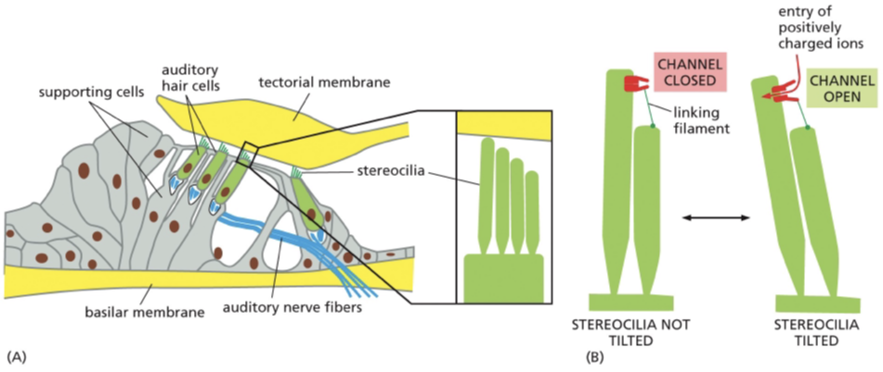
Auditory hair cells
classic example of mechanically gated channels
sound vibration pulls them open, causing ions to flow into the hair cells this ion flow sets up an electrical signal that is transmitted from the hair cell to the auditory nerve - then conveys the signal to the brain
from ppt
•Mechanically gated channels and auditory reception
•Stereocilia of auditory hair cells are attached to the tectorial membrane which vibrates due to sound waves
•Movement of the stereo cillia open mechanically gated ion channels resulting in an influx of (+) charged ions
This activates the underlying auditory nerves
True or false In both plants and animals both mechanically gated and voltage gated ion channels underlie the ability to generate an electric impulse
true
For voltage-gated channels, a change in the membrane potential has what effect on the channel?
it alters the probability that the channel will be found in its open confirmation
To pass through the pore of an ion channel, what must be true of an ion?
It must interact with polar groups in the narrowest part of the channel.
Neurons
fundamental task: receive, integrate, and transmit signals
every neuron consists of
cell body
axon- long extension that conducts electrical signals away from the cell body and toward distant target cells
dendrites - shorter branch extensions
signals in the nervous system are carried and communicated by changes in the electrical potential across a neuron’s plasma membrane.
action potential
traveling wave of electrical excitement
also known as a nerve impulse
experiment with giant axon of squid
from the studies they found how action potentials are the direct consequence of the properties of voltage gated ion channels in in the axonal plasma membrane
ppt notes
show that without voltage gates ion channels action potentials wouldnt be reached
when a neuron is stimulated its plasma membrane will become _____
depolarized: its membrane potential shifts to less negative value (towards 0)
if the depolarization is sufficiently large it will cause?
voltage gated Na+ channels in the membrane open briefly at the site
channel flicker open - allow small amounts of Na+ to enter the cell down the steep electrochemical gradient
influx of + charge depolarizes the membrane further (makes the membrane potential less negative)
voltage gated channels are opened due to depolarization of the surrounding membrane, then…
then become inactivated before they recover
cell has an automatic inactivating mechainsm
“timer” that adopts a special inactivated confirmation, where the channel is closed even though the membrane is still depolarized
remain inactivated until until the membrane potential has returned to its resting (negative value)
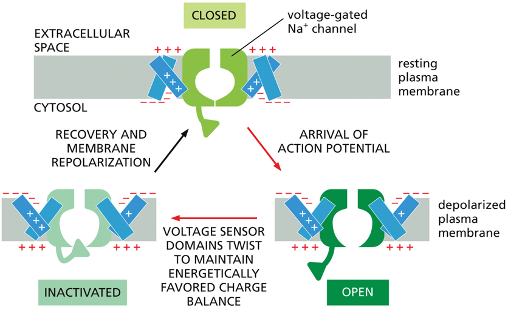
how does the process return to the resting state?
Process
channels open in response to depolarization
Influx of Na+ through the Na+ channels
the channel stays open till it reaches its peak
then K+ ions (carrying a positive charge) start to flow out of the cell , down their electrochemical gradient
massive outflow of potassium through voltage gated channels brings the membrane back to the resting state
ppt
the influx of Na from voltage gated channels triggers voltage gated K channels which help reestablish the resting membrane potential
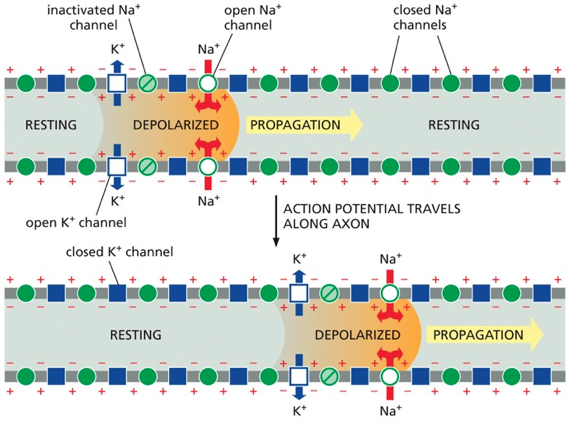
When an action potential reaches the nerve terminals at the end of an axon, the signal must somehow be relayed to the target cells that the terminals contact—usually neurons or muscle cells. The signal is transmitted to the target cells at specialized junctions known as
synapses- specialized junctions where the nerve cell communicates with another cell usually via a neurotransmitters
neurons connect to their target cells as _____
synapses
pre-synaptic cells release ?
neurotransmitters to the receiving/ post synaptic cell
action potentials reach the end of pre-synaptic cells and ?
trigger voltage gated calcium channels
the influx of calcium triggers the release of synaptic vesicles
neurotranmitters trigger ____ gated ion channels in the post synaptic cell membrane and result?
triggers ligand gated ions
results in the membrane being depolarized
transmitter gated ion channels
transmemebrane receptor protein or protein complex that opens in response to binding of a neurotransmitter, allowing the passage og specific inorganic action potential in post synaptic cells
post synaptic cell can also be a muscle cell
the influx of sodium will then trigger
trigger the release of calcium from the sarcoplasmic reticulum and muscle contraction
In vertebrates, the neurotransmitter acetylcholine stimulates ______ by binding to the acetylcholine receptor, a neurotransmitter-gated ion channel in the muscle cell’s membrane
muscle contraction
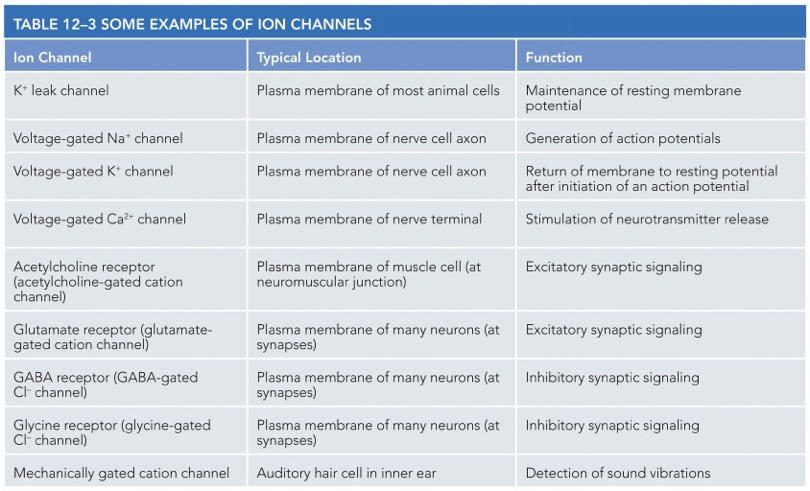
The depolarization of the nerve-terminal plasma membrane triggers the secretion of neurotransmitters by opening which of the following?
voltage gated Na +channels in the plasma membrane
voltage gated K+channels in the plasma membrane
transmitter gated Ca 2+channels in the plasma membrane
voltage gated Ca2+ channels in the plasma membrane
voltage gated Ca2+ channels in the plasma membrane
When transmitter-gated ion channels in the membrane of a postsynaptic cell open in response to neurotransmitter binding, what happens?
The channels alter the ion permeability of the postsynaptic membrane, which in turn may depolarize the postsynaptic membrane.